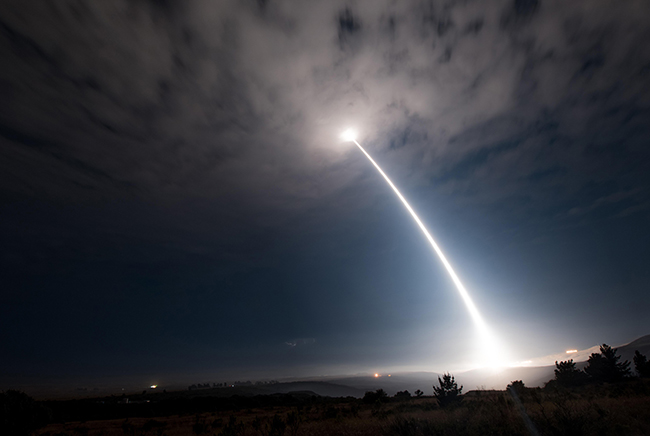
An unarmed Minuteman III intercontinental ballistic missile launches during an operational test at 2:10 a.m. Pacific Daylight Time Wednesday, Aug. 2, 2017, at Vandenberg AFB, Calif. Air Force photo by SrA. Ian Dudley.
The next estimate of the cost of the Ground-Based Strategic Deterrent will likely go up due to expected higher costs for military construction, but swift progress in developing the missile itself leads the head of Air Force Global Strike Command to believe the ultimate cost will be “tens of billions” less than now projected.
“You may see a slight change in the service cost position … based on infrastructure,” AFGSC Commander Gen. Timothy Ray told reporters in Washington, D.C., on Wednesday. He did not characterize what the change may be, but said he expected the “service cost position [to] come down” over time.
The near-term additional costs have to do with upgrading the missile silos, he explained, but thanks to digital engineering that enables developers to see instantaneously how small tweaks of the missile can yield big sustainment savings later on, the Air Force will realize “tens of billions in savings” eventually; probably around the time a downselect is made between Boeing and Northrop Grumman next year.
Typically, “by this stage, you would be on your second design cycle, Ray said. “We’re past nine, with both contenders, and the insights are incredible.”
Modifications to the missile also will be much easier thanks to built-in modularity, meaning a missile change “will be very simple. It requires two-thirds less convoys, two-thirds less time you expose the site, 10-15 percent [savings] in terms of manpower,” and other cost avoidance. He said the GBSD—the planned replacement for the service’s aging intercontinental ballistic missiles—is considered the best-run of the Air Force’s many major programs at this point.
For similar reasons, Ray expects the Long-Range Standoff cruise missile will cost “considerably less” to develop and build than initially expected. In both cases, Ray said, the Air Force has done a good job of setting requirements, not changing those requirements, and creating opportunity for competition among companies.
The LRSO—the nuclear-armed successor to the AGM-86B ALCM—has a relatively pedestrian pace of development, but Ray said the longer time carrying two contractors—Lockheed Martin and Raytheon—through technology maturation and risk reduction will pay dividends later.
“In the TMRR phase, you’re actually doing EMD [engineering and manufacturing development]-type activities,” he explained. So what you’re doing is driving the two competitors to mate the warhead with DOE [Department of Energy] as part of the competitive process.” Doing this without competition is “probably not in our best interest,” because contractors wouldn’t have “any motivation” to get it right, he said.
Instead, he reported “very, very good dialog” among USAF, the DOE, and the contractors, and said, “We’re very pleased” with progress on the program. The approach will bring early flight test and early focus on reliability, which will be “one of the biggest drivers” of cost on the project. Flight test isn’t the place to be worried “about integrating the warhead,” Ray observed.
Ray said it’s too soon to say if the LRSO will be adapted to a conventional weapon.
“We’re going to have a conversation about longer [range], more precise capabilities,” Ray said. “What I see as attributes of the LRSO would make the very good foundations for a conventional missile in the future,” he asserted, quickly adding that saying so “is not a commitment to go down that path.” But “that thinking is in play right now.”
The ALCM was adapted into a conventional weapon, known as the CALCM, used first in the 1991 Gulf War and most conflicts thereafter.
This story was updated on Nov. 26 to correctly reference the AGM-86B ALCM and to include the full name of Air Force Global Strike Command boss Gen. Timothy Ray.